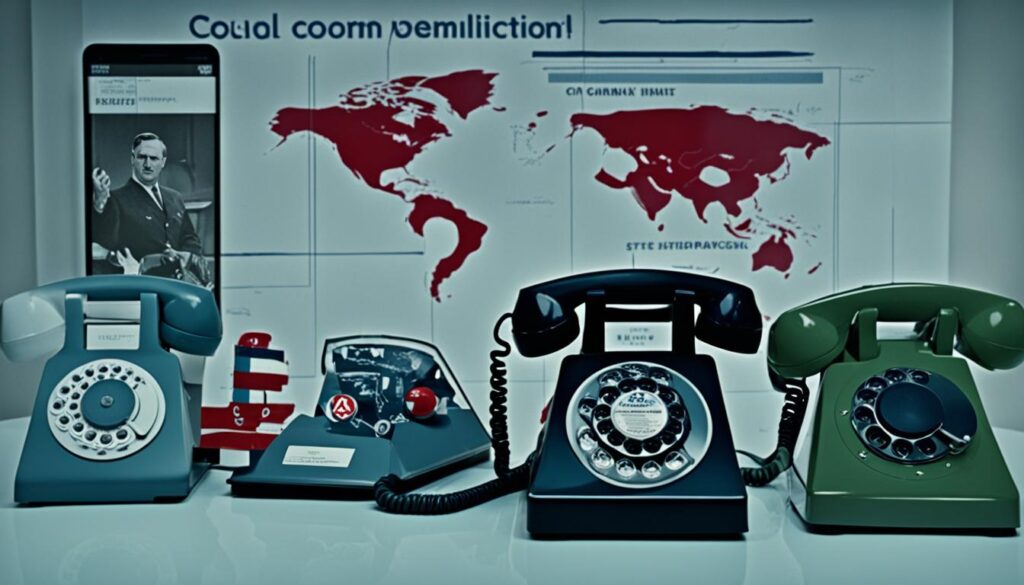The red telephone linking the White House to the Kremlin during the Cold War is a myth. No direct phone line existed between U.S. presidents and Soviet leaders. Instead, they used a different system: the Washington-Moscow hotline.
This hotline was set up after the Cuban Missile Crisis in 1963. It started as a teletype system sending written messages through a transatlantic cable. The American end was in the Pentagon, not the White House.
Over time, the hotline got better. It added satellite links and high-speed fax machines. In 2008, it even got a secure computer link for emails.
Key Takeaways
- No red phone existed between the U.S. and Soviet Union during the Cold War
- The Washington-Moscow hotline was established in 1963 after the Cuban Missile Crisis
- The hotline initially used teletype machines and a transatlantic cable
- The American terminal was housed in the Pentagon, not the White House
- The hotline was upgraded over time to include satellite links, fax machines, and secure email
The Washington-Moscow Hotline: A Direct Communications Link
The Washington-Moscow hotline was proposed in the 1950s as a direct link between the U.S. and Soviet Union. The 1962 Cuban Missile Crisis highlighted the need for better communication. Diplomatic messages took hours to reach their destination, causing dangerous delays during Cold War tensions.
After the crisis, the U.S. and Soviet Union met in Geneva in 1963. They signed a memorandum to establish a direct communications link. The hotline went live on August 30, 1963, becoming crucial for managing U.S.-Soviet relations.
The hotline helped defuse tensions during several crises, including the 1967 Six-Day War. It also played a role in the 1971 Indo-Pakistani War and the 1973 Yom Kippur War. The hotline facilitated communication during the 1979 Soviet invasion of Afghanistan.
Direct, rapid communication between Washington and Moscow prevented misunderstandings. It helped avoid miscalculations that could have led to full-scale conflicts. The hotline was vital for managing crises effectively.
The Washington-Moscow hotline improved U.S.-Soviet relations and reduced the risk of nuclear war. It provided a crucial channel for communication during the Cold War years. This direct link helped maintain stability in a tumultuous period.
Technology and Procedures of the Hotline
The hotline technology has changed a lot since 1963. At first, it used telegraph circuits through London, Copenhagen, Stockholm, and Helsinki. Messages were encrypted using a system called ETCRRM II for secure communication.
In 1971, the hotline got better with satellite communication. This made messages faster and more reliable. It reduced the risk of communication problems.

In 1986, they added high-speed fax capability. This allowed sending images and documents. Two years later, fax links replaced teletype circuits. The hotline moved to newer satellites.
In 2008, the hotline became a secure computer link using email. This lets messages travel almost instantly. It’s much faster for important talks between the United States and Russia.
The hotline is tested every hour to make sure it works. This ensures it’s always ready for talks, especially during tense times. Advanced encryption, satellites, and regular upkeep keep the hotline reliable.
Cold War Red Phone Myth in Pop Culture
The red phone myth captivated imaginations during the Cold War. It appeared in movies, TV shows, and political campaigns. This idea of a direct line between U.S. and Soviet leaders was inaccurate.
Stanley Kubrick’s 1964 film “Dr. Strangelove” showed a red phone scene during a nuclear crisis. “Fail-Safe,” released the same year, featured a similar scenario. These movies strengthened the red phone myth.
TV shows like “Batman” and “Get Smart” also spread the red phone myth. They showed it as a direct communication tool between U.S. and Soviet leaders. These entertaining portrayals led to misunderstandings about the real hotline.
The red phone symbol appeared in the 1984 U.S. presidential election. Candidates Mondale and Reagan used it in ads to question their opponent’s crisis management skills. These ads played on public perception of the red phone.
The real Washington-Moscow hotline was different from the myth. It didn’t use a red phone or direct voice communication. Instead, it relied on teletype machines and later satellite communication for written messages.
Usage of the Hotline During Major World Events
The Washington-Moscow hotline has been vital during international crises since 1963. President Johnson first used it in the 1967 Six-Day War. He informed Soviets about U.S. Air Force movements in the Mediterranean.
The hotline was used during the 1971 Indo-Pakistani War and 1973 Yom Kippur War. It was also employed during the 1974 Turkish invasion of Cyprus under President Nixon.
President Carter used it once during the Soviet-Afghan War in 1979. Reagan relied on it for events in Lebanon and Poland. The hotline was crucial during the 1991 Gulf War.
It played a key role after the 9/11 attacks in 2001. The hotline was also used following the Iraq War in 2003. This shows its ongoing importance in managing global crises.
The hotline remains a crucial communication channel between the U.S. and Russia. It allows for swift dialogue during tense times. This tool helps prevent misunderstandings that could lead to conflicts.

Leave a Reply